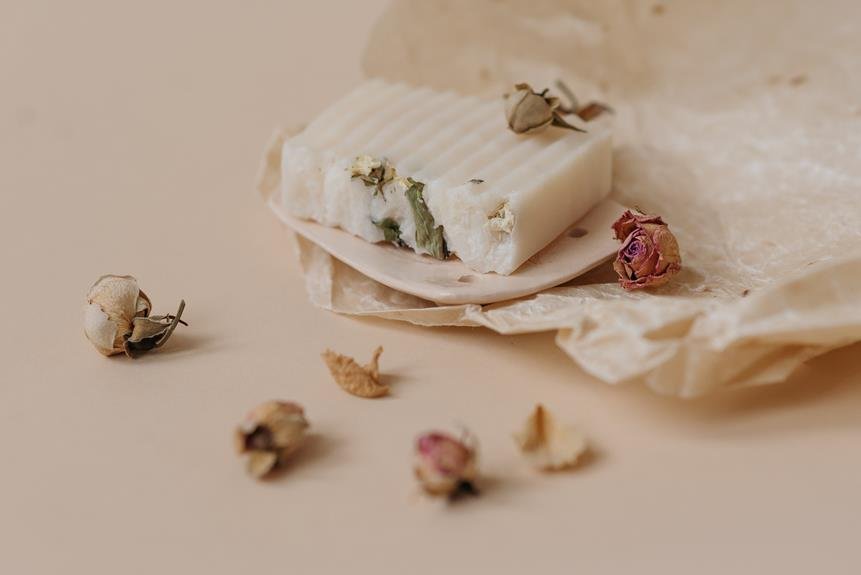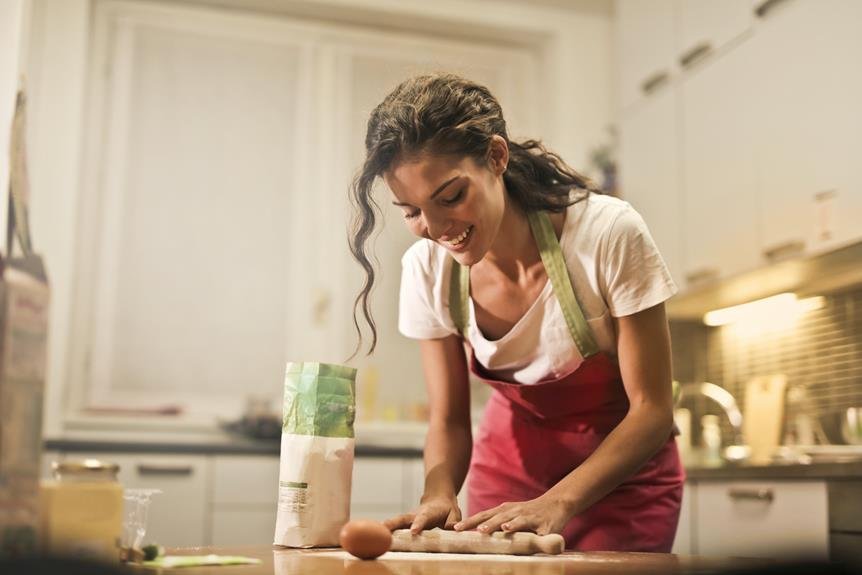Step into a world where time stands still, and the art of soap making takes center stage. Imagine the scent of lavender wafting through the air, as your hands delicately mold a bar of soap, crafted with love and care. Artisanal soap making is a timeless tradition that brings together the best of nature and creativity. But what makes these handcrafted beauties so special? And how can they transform your daily skincare routine into a truly luxurious experience? Uncover the secrets behind the art of artisanal soap making and indulge in the gift of handmade beauty.
The History of Artisanal Soap Making
Step back in time and immerse yourself in the captivating history of artisanal soap making, a craft that has been passed down through generations, preserving the ancient traditions and techniques that have shaped this exquisite art form.
The origins of artisanal soap making can be traced back thousands of years to ancient civilizations such as the Babylonians, Egyptians, and Greeks. These early societies recognized the value of soap not only for personal hygiene but also for medicinal and spiritual purposes. The techniques used to create soap were rudimentary, involving the combination of animal fats or vegetable oils with alkaline substances like ash or lye. These simple yet effective methods laid the foundation for the intricate and elaborate soap making practices that would develop over time.
As civilizations advanced, so did the techniques of soap making. The Romans, in particular, elevated soap making to an art form, using luxurious ingredients like olive oil and scented herbs. They perfected the process of saponification, the chemical reaction that occurs when oils or fats are mixed with an alkali, resulting in the formation of soap. This groundbreaking discovery revolutionized the soap making industry and paved the way for the production of different types of soap, each with its unique properties and fragrances.
Throughout history, soap making techniques continued to evolve and improve. The Middle Ages saw the rise of soap guilds, which regulated the production and quality of soap. These guilds guarded the secrets of soap making, passing down their knowledge from one generation to the next. With the advent of the Industrial Revolution, soap making became mechanized, leading to mass production and the availability of soap to the general population.
Despite the advancements in technology, artisanal soap making has managed to survive and thrive. Today, skilled artisans continue to employ traditional techniques, carefully selecting high-quality ingredients and handcrafting each batch of soap with precision and passion. The art of soap making has become a form of self-expression, with artisans incorporating innovative designs, colors, textures, and scents into their creations.
Step into the world of artisanal soap making, and you will witness the beauty of a craft that has stood the test of time. The origins and techniques that have been passed down through generations have shaped this art form into something truly extraordinary. Each bar of artisanal soap is a testament to the skill, dedication, and creativity of the soap makers who have devoted their lives to preserving this ancient tradition. So take a step back in time, embrace the history, and indulge in the luxury of handcrafted beauty.
Benefits of Using Artisanal Soaps
Immerse yourself in the luxurious world of artisanal soaps and discover the transformative benefits they offer for your skin and senses. When it comes to skincare, using artisanal soaps can be a game-changer. These handcrafted beauties are made with love and attention to detail, using natural ingredients that nourish and pamper your skin. One of the biggest benefits of using artisanal soaps is that they are free from harsh chemicals and synthetic ingredients found in commercial soaps. This means that they are gentle on your skin and less likely to cause irritation or dryness.
But the benefits don't stop there. Artisanal soaps are often infused with essential oils, herbs, and botanicals, which not only make them smell divine but also provide additional skincare benefits. Lavender, for example, is known for its calming properties and can help soothe irritated skin. Tea tree oil, on the other hand, is great for oily or acne-prone skin due to its antibacterial properties.
To make the most out of your artisanal soap experience, here are a few skincare tips. First, choose a soap that suits your skin type. If you have dry skin, look for soaps that are moisturizing and gentle. For oily skin, opt for soaps that are clarifying and balancing. Second, make sure to lather the soap well and massage it into your skin for a few minutes to allow the ingredients to work their magic. Lastly, rinse thoroughly and pat your skin dry with a soft towel.
Exploring Natural Ingredients in Artisanal Soaps
Discover a world of natural wonders as you delve into the realm of artisanal soaps, where every bar is crafted with care and infused with the finest ingredients nature has to offer. Exploring different scents in handmade soaps is like embarking on a fragrant journey. From the refreshing scent of lavender to the invigorating aroma of citrus, there is a soap for every mood and occasion. These natural scents are not just pleasing to the senses, but they also offer a range of benefits for your skin.
The benefits of using handmade soaps are numerous. Unlike commercial soaps, which often contain harsh chemicals and synthetic fragrances, artisanal soaps are made with natural ingredients that are gentle on the skin. They are typically enriched with nourishing oils such as olive oil, coconut oil, and shea butter, which help moisturize and soften the skin. These ingredients also provide essential nutrients and antioxidants that promote healthy skin.
In addition to their nourishing properties, artisanal soaps are also environmentally friendly. They are often made using sustainable and biodegradable ingredients, and they are free from harmful additives that can pollute waterways and harm aquatic life.
Techniques and Tools in Artisanal Soap Making
Crafting artisanal soaps is a captivating blend of creativity, precision, and mastery of techniques and tools. The process of making soap involves a series of steps, each requiring specific techniques to achieve the desired result. One commonly used technique is the cold process method, where oils and lye are combined to create a chemical reaction called saponification. This method allows for the preservation of the natural properties of the ingredients, resulting in a gentle and nourishing soap. Another technique is the hot process method, which involves cooking the soap mixture to speed up the saponification process. This method is often used to create rustic and textured soaps. Soap makers also employ various techniques to add colors, scents, and textures to their creations. These techniques include swirls, layers, and embeds, which add visual interest and uniqueness to the final product. When it comes to tools, soap makers rely on a range of equipment such as mixing bowls, molds, thermometers, and stick blenders. These tools are essential for measuring ingredients accurately, achieving the desired consistency, and ensuring the safety of the soap maker. Soap making is a craft that requires skill, knowledge, and a deep understanding of the techniques and tools involved. With practice and experimentation, one can master the art of soap making and create beautiful, handcrafted soaps.
Creating Unique Designs and Fragrances in Artisanal Soaps
Let your imagination take flight as you explore the art of creating unique designs and fragrances in artisanal soaps. With custom soap molds at your disposal, the possibilities are endless. These molds allow you to shape your soap into intricate patterns and designs, adding a touch of artistry to your creations. From delicate flowers to geometric shapes, you can bring any vision to life.
But it's not just the shape that makes artisanal soaps truly special. It's the colors and textures that can elevate your creations to a whole new level. Experimenting with different hues and shades can create stunning visual effects. Imagine a soap that mimics the vibrant colors of a sunset or the soothing blues of the ocean. By blending and layering colors, you can achieve a depth and richness that is truly mesmerizing.
Textures also play a vital role in creating unique soaps. From smooth and silky to exfoliating and invigorating, the possibilities are endless. Add crushed herbs or seeds for a gentle exfoliation, or incorporate swirls and ripples for a visually stunning effect. The texture of your soap can enhance the sensory experience and make each use a delightful treat for the senses.
Conclusion
In conclusion, artisanal soap making is a captivating blend of history, benefits, natural ingredients, techniques, and creativity. It is a gift that embodies the beauty and artistry of handcrafted products. By using artisanal soaps, you not only indulge in the luxurious experience of nourishing your skin, but also support local artisans and the preservation of traditional techniques. So why settle for mass-produced soaps when you can indulge in the exquisite beauty of artisanal creations? Treat yourself and your loved ones to the gift of handcrafted beauty.

